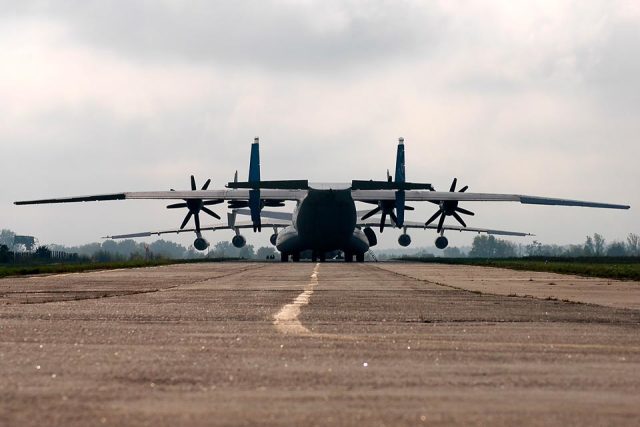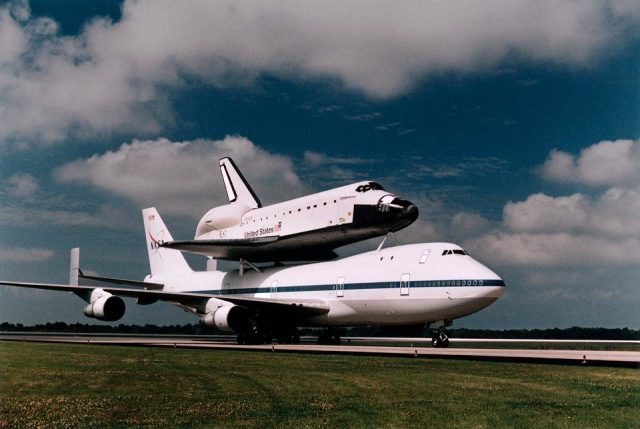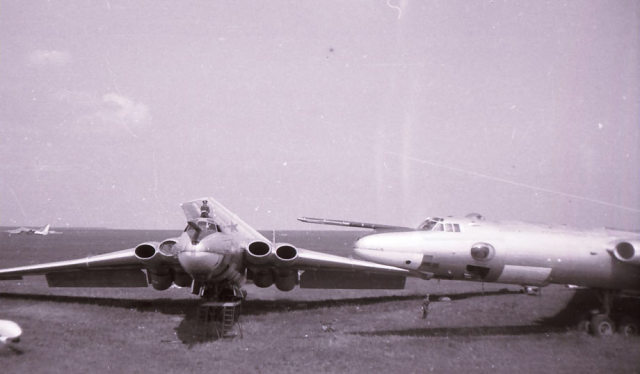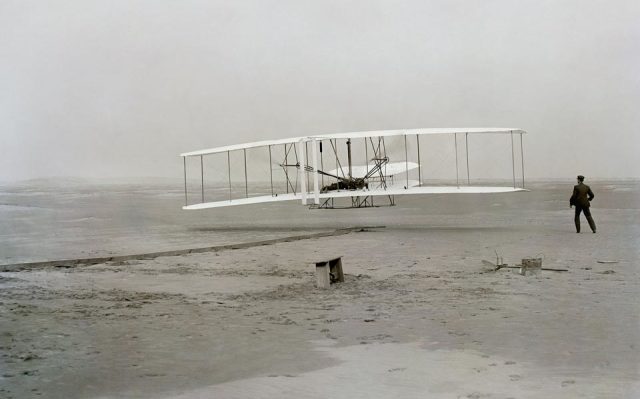At the end of August 2016, the Ukrainian state-owned Antonov company and the Chinese AICC Corporation signed an agreement on cooperation on the program of the AN-225 "Mriya" heavy transport aircraft of ultra-large payload. The agreement provides for the completion of the second aircraft of this type and its delivery to China, as well as the deployment of licensed production of AN-225 transporters on the territory of the Asian state. We decided to recall the history of the world's largest transport aircraft, which at one time was considered as an air launch platform for reusable spacecraft, and not as an ordinary courier for heavy dimensional cargo
From the editors, this text was first published in September 2016. At the end of February 2022, during an attempt by the Russian military to seize Gostomel airfield, the world's largest AN-225 Mriya transport aircraft was destroyed. Read the description of these events in the blog Vadim Lukashevich.
The AN-225 "Mriya" ("Dream") was designed in the USSR in just four years and made its first flight in 1988. But the history of the most famous transport worker today began earlier, back in the 1970s. Then in the USSR, as a response to the American Apollo lunar program, they began to develop a new universal rocket and space transport system. It was supposed to provide manned flights to the Moon and Mars, the launch of Buran transport spacecraft, the launch of military cargo and orbital stations into orbit. These works have been carried out since 1976 as part of the large-scale project "Dawn", later renamed "Energy".
According to the resolution of the Central Committee of the CPSU and the Council of Ministers of the USSR, the scientific and production association Energia, NPO Molniya, the Burevestnik Experimental design bureau and the Myasishchev Experimental machine-building plant were engaged in work on the Dawn. The latter was responsible for the creation of a heavy transport aircraft that could carry heavy and large components of the new launch vehicle over long distances, where their delivery by conventional sea or rail transport would be either extremely complicated or impossible at all.
The fact is that the enterprises of the Soviet space and military industries were very scattered across the republics of the USSR. For example, Energia and Molniya were located in Moscow at that time, the Myasishchev plant was located in Zhukovsky near Moscow, and Burevestnik was located in Nizhny Novgorod. Some details of the missiles of the project "Dawn" were made in Ukraine. Thus, the control systems were manufactured in Kharkov by the scientific and production association "Electropribor". Tests of the components of the new rocket were to take place at the main Soviet Baikonur cosmodrome in Kazakhstan.
The time allotted for the development of the project was not enough. At the first stage, the Antonov Design Bureau was involved in the work on it, which proposed the modernization and modification of the existing An-22 transport vehicle. But this aircraft, in terms of its size and capabilities, was not suitable for the Dawn project. In parallel, the development of a new AN-124 Ruslan transport aircraft was carried out, but its completion was planned for the 1980s. For this reason, the participants of the Dawn project decided to create a new transport vehicle based on existing 3M strategic bombers.

AN-22 transport aircraft
Image source: Wikimedia Commons
To develop a new aircraft, designated 3M-T "Atlant" (T — transport), the USSR Air Force withdrew three 3MN bombers with tail numbers "1402", "1502" and "1504" from its composition. The latter was reconfigured into a static sample for strength testing. The remaining two aircraft were redesigned, which was also attended by specialists from the Khrunichev Plant, Tashkent and Omsk Aviation Production Associations. The bombers received a new tail, reinforced landing gear and airframe, and also lost the flaps of the bomb bay and weapons.

NASA's special transport aircraft - Boeing 747 Shuttle Carrier Aircraft - transports the American reusable shuttle "Endeavour" (Space Shuttle Orbiter Endeavour), 1998
Image Source: NASA/KSCThe
Technical improvements of strategic aircraft were made so that they could carry "sensitive" cargo inside the cargo compartments and overall - on a special dorsal mount. It was planned to attach loads comparable in length to the length of the aircraft, for example, the fuel tanks of the launch vehicle, fairings, stages. The Buran spacecraft, which had been created since 1976 as a military response to the American Space Shuttle program, was also planned to be transported on the same mount. Moscow considered this program military, posing a threat to the USSR.
The first 3M-T already in 1982 performed the first two transport flights from Kuibyshev (now Samara) to Baikonur. The transporter transported a hydrogen tank, nose and tail fairings, as well as an oxygen tank, instrument and engine compartments and the head of the Energia launch vehicle. In the same year, the aircraft entered service with the USSR Air Force. Its length was 58.7 meters, wingspan - 53.14 meters, height - 14 meters. With a maximum take-off weight of 210 tons, the 3M-T could carry cargo weighing up to 50 tons at a distance of up to 9.4 thousand kilometers. In 1983, when one of the transporters was already carrying out regular cargo flights to Baikonur, the second copy of the aircraft began flight tests with a mock-up of the Buran, which had its keel disconnected. The weight of the layout was about 45 tons.
In order to maintain secrecy, the 3M-T was repainted in the colors of Aeroflot after it was put into service. At the same time, in order to hide the bomber's past of the aircraft, they wanted to erase the inscription "3M-T" on its board, but in the end they did otherwise — they corrected the number "3" to the letter "B" by drawing a stick on the left. According to official documents, the aircraft still passed under the designation 3M-T. In 1988, one of the Atlanteans delivered parts of the Buran spacecraft to Baikonur. In October 1988, Buran made the first (and last) unmanned flight around the Earth.

Decommissioned 3M strategic bombers under Engels, 1989
Image source: Alner / Wikimedia Commons
Shortly after the successful launch of Buran, the VM-T program was curtailed, and the aircraft were mothballed indefinitely. In 1989, they were already officially withdrawn from service by the USSR Air Force. During the entire period of operation, VM-T performed about 150 test and transport flights. The reason for the rejection of the VM-T was the Soviet program for the development of a multi-purpose aerospace system (MAKS), of which Buran was originally a part (then the developers decided to create a new spacecraft). The carrying capacity of the "Atlanta" for the purposes of the new program, which started in 1981, was sorely lacking.
According to experts, the program needed transporters with a carrying capacity of at least 250 tons. The fact is that the MAKS project assumed the use of a carrier carrier as an air launch platform for a spacecraft. The aircraft was supposed to carry a single-use first stage of the space complex, which is a huge fuel tank, and the second stage was directly reusable spacecraft. The latter was designed according to the scheme of a rocket plane - an aircraft with a short wing, rocket engines and a heat-resistant coating.
The main developer of the MAKS project was NPO Molniya. The company's designers considered three variants of a reusable space system. In the first, the transport plane lifted a disposable fuel tank and a manned spacecraft with astronauts and cargo on board with a total weight of up to seven tons. The second option involved the addition of a single-use rocket stage, which would increase the total payload capacity of the space system to 18 tons. The third option involved the use of an unmanned spacecraft. In all variants, a transport plane with a spacecraft on its back had to climb to a height of ten thousand meters and make a "slide", at the peak of which the cargo would detach and continue flying into space on its own.
The MAX program promised many advantages. Firstly, transport planes could take off from the runways of conventional airfields and airports, that is, there was no need for regular use of distant Baikonur. Secondly, such a scheme made launching various cargoes into space significantly cheaper compared to conventional launch vehicles. Thirdly, the combination of a transport aircraft and a spacecraft would significantly accelerate the launch of astronauts and cargo into orbit, since it did not require such careful preparation for launch as launch vehicles.
In 1984, the development of a new heavy transport aircraft to replace the VM-T began. He received the designation AN-225. Just as in the case of "Atlant", time was running out. The Dawn program, already renamed Energia, required aircraft to transport parts of launch vehicles. She also needed an aircraft that could deliver Burans to Baikonur from alternate airfields where they could land. To quickly create a new transport vehicle that is more lifting than the VM-T, the developers decided to use the An-124 Ruslan project that was still being developed.
To do this, the Antonov design bureau involved in the project changed the design of the AN-124, which made its first flight in December 1982. The redesigned aircraft received fuselage inserts in front and behind the wing, which increased the length of the aircraft from 69 to 84 meters. The right and left wing consoles also received lengthening inserts — the wing of increased length allowed to increase the lifting force, and hence the load capacity. The wingspan of the AN-225 after lengthening was 88.4 meters compared to the original 73 meters.
As a result of all alterations, the volume of the AN-225 cargo compartment reached 1.3 thousand cubic meters: 6.4 meters wide, 4.4 meters high and 43.4 meters long. For comparison, the distance that during the first flight in 1903 flew the very first motorized aircraft - the "Flyer" of the Wright brothers, was 36.5 meters. It was possible to carry cargo into the AN-225's internal compartment in the same way as the basic AN-124 — through an opening in the front of the fuselage, which opens when the nose section with the cockpit is raised. At the same time, the designers refused the ramp (cargo door) in the tail section, which is available to Ruslan, for reasons of weight reduction.

The first successful flight of the Wright Brothers' Flyer
Image Source: Library Of Congress
External fasteners were installed above the AN-225 fuselage. In order for the aircraft to carry cargo as long as the fuselage, the designers redesigned the tail of the basic AN-124 - the keels with rudders were mounted on the ends of the horizontal stabilizer consoles. Thus, part of the overall cargo could lie between the keels and not interfere with the normal control of the aircraft.
Since the AN-225 was not planned to be used for military purposes, as envisaged by the AN-124 project, the aircraft received shorter landing gear. Because of this, as well as because of its large mass (the maximum take-off weight is 600 tons), Mriya lost the opportunity to use unpaved airfields for take—off and landing. 16 landing gear racks with 32 wheels were installed on the aircraft: four wheels on the front two racks and 28 on the main ones, 14 on each side. The front and rear pairs of wheels of the main landing gear can be rotated, allowing the aircraft to turn around within the runways with a width of only 60 meters.
On the wing console, the designers installed one additional suspension for turbofan jet engines D-18T, capable of developing thrust up to 229.9 kilonewtons. Thus, the number of power plants in comparison with the basic AN-124 project increased by two: from four to six units. This was necessary not so much to propel the aircraft (although this was also important), but to create redundancy. The AN-225 had to carry expensive cargo, including prototypes that had been assembled piece by piece for a long time. Six engines served as a guarantee that the plane would not fall somewhere in the taiga due to the failure of part of the power plants.
In its original form, the Mriya was supposed to become part of MAKS only as a transport of spacecraft and parts of launch vehicles. On the basis of the aircraft, the designers planned to create an even more lifting An-325. According to its scheme, it would be practically no different from the AN-225, but it would have more powerful engines and a modified cargo attachment system to the upper part of the fuselage. The AN-325 was considered as the main platform for the air launch of orbital aircraft and the modified cargo attachment would just allow the spacecraft to be unfastened in flight at the peak of the "hill".
The first flight of the Mriya took place on December 21, 1988, and the aircraft began performing cargo flights in 1989. At the same time, the Soviet government began to think about the commercialization of the AN-225, which would transport cargo of foreign customers for money. For these purposes, it was planned to build a second transport vehicle, but due to the collapse of the USSR and the termination of funding for the project, the work was not completed. Today, the second "Mriya" in the form of a fuselage, wing consoles and tail is stored in the hangar of the Antonov state company in Ukraine. The readiness of the second sample of the aircraft is 70 percent.
The AN-225 is capable of speeds up to 850 kilometers per hour. The cruising speed of the transport is 800 kilometers per hour, and the flight range is about 15 thousand kilometers. From 1989 until 2001, the "Mriya" was not used. Antonov Airlines, which was established in 1989 and was responsible for cargo transportation, had enough conventional AN-124 aircraft to fulfill orders. In addition, the company did not have enough funds to modify the AN-225 for conventional cargo transportation. And in the Burana project, suspended in 1990 and finally closed in 1993, the AN-225 was no longer used.
It was only in the mid-1990s that Antonov Airlines began to receive applications for the transportation of heavy overall cargo. An-124 could not help with this. Then the air carrier carried out the modernization of the Mriya, removing special equipment left over from the space program, refitting the cargo compartment and equipping it with a rigid deck, as well as replacing outdated engines with more modern versions of them. As a result of the work carried out, the maximum take-off weight of the AN-225 increased to 640 tons. At the same time, it was possible to achieve an increase in the estimated maximum load capacity.
On May 23, 2001, the Interstate Aviation Committee issued Antonov a type certificate for the AN-225 transport aircraft with the factory number 01-01 and the tail number UR-86060. Such a certificate allows the aircraft to operate in a single airspace on a par with other aircraft and helicopters. The received document allowed Antonov Airlines to make commercial cargo flights on AN-225. In the same year 2001, tests were carried out for the maximum carrying capacity of the Mriya: a transport vehicle with four main battle tanks with a total weight of 253.8 tons flew at an altitude of 10.7 thousand meters along a closed route with a length of one thousand kilometers. The average flight speed was 763 kilometers per hour.
The AN-225 performed its first commercial flight on January 3, 2002. The plane transported 216 thousand dry rations with a total weight of 187.5 tons from Germany to Oman. They were intended for the American military contingent stationed in Tumrait. Later, the aircraft was regularly used to transport provisions, ammunition and military equipment to the Middle East for the Canadian and American military. In August 2004, Mriya transported several units of special equipment, including equipment for gas production, from Prague to Tashkent. The total weight of the cargo was about 250 tons. In 2009, Mriya transported a generator weighing 174 tons and a holding frame for it weighing 13.6 tons from Frankfurt to Yerevan.
"Mriya" regularly performs cargo transportation today. In 2011, Anatoly Serdyukov, who then held the post of Defense Minister, was interested in the possibility of completing the second model of the AN-225 in the interests of the Russian Air Force. It was not specified exactly how the heavy transport vehicle was planned to be used in the Russian troops. According to unconfirmed reports, it was planned to carry parts of promising heavy intercontinental ballistic missiles, as well as heavy and superheavy launch vehicles on the plane. However, later the Russian military department was no longer interested in the Ukrainian "Mriya".
But in 2012 it became known about the resumption of work on the MAKS program. The new basic project involved the use of a modernized VM-T transport aircraft and a modified stratospheric M-55 Geophysics aircraft. It was assumed that the modified M-55 would launch at an altitude of ten thousand meters from the carrier aircraft and, using a rocket engine, accelerate to 1.2 thousand kilometers per hour and climb to an altitude of 120 kilometers. Such a bundle was planned to be used for space tourist flights and the delivery of light commercial satellites into orbit. One of the variants of the renewed MAKS project also implied the use of the completed AN-225. The current state of the project is unknown.
After the outbreak of the military conflict in the south-east of Ukraine in 2014, work on joint projects between Kiev and Moscow stopped. Today, Russia is no longer considering the possibility of buying a second copy of the AN-225 or organizing its mass production. But China, which is actively developing the military and civilian industries and needs a heavy transport aircraft of the AN-225 type to transport various cargoes, from wing consoles of promising aircraft to blocks of ballistic missiles and launch vehicles, became interested in the aircraft.
In order to partially cover the needs for air cargo transportation, the Chinese aviation industry has developed a new Y-20 transport aircraft in nine years. In July of this year, it entered service with the Air Forces of the People's Liberation Army of China. The length of the Y-20 is about 47 meters, the height is 15 meters, and the wingspan is 45 meters with a maximum take-off weight of 220 tons. The Chinese transport vehicle can reach speeds of up to 830 kilometers per hour and fly at full load at a distance of up to 4.4 thousand kilometers. The Y-20 is designed to transport cargo weighing up to 66 tons.
According to unconfirmed reports, the main design work on the Y-20 project was carried out by the Ukrainian state company Antonov. In any case, in 2004, three years before the start of the development of the Y-20, Antonov proposed to China the creation of a new heavy-class transport aircraft with a payload capacity of 50 tons. In 2015, the Chinese aircraft manufacturer AVIC announced the beginning of the development of a new super-heavy transport aircraft, which will be based on the Y-20. According to the concern, the new transport vehicle will correspond to the Ukrainian AN-225 "Mriya".
Already in the spring of 2016, it became known about negotiations between the Chinese company Shaanxi Aircraft, which is part of the AVIC concern, and the state-owned Antonov company on the completion of the second An-225 model and its transfer to China. In addition, Chinese investors were also interested in the possibility of deploying serial production of AN-225-type transporters in China. Earlier, Antonov estimated the cost of creating a serial production of such aircraft at three to four billion dollars. At the same time, it was planned to start producing the AN-225 in the old form, but with new aviation equipment.
Even if we assume that the program of cooperation between Ukraine and China under the AN-225 program will be implemented in full, the appearance of the first serial Chinese "Mriya" should not be expected soon. The fact is that the organization of serial production will require the cooperation of several enterprises, work on the selection and integration of new aviation equipment and the implementation of a flight test program for an essentially new aircraft. And if China wants to use heavy transporters outside its borders, it will have to certify the AN-225. Until then, the overall cargo will continue to be carried by the Ukrainian "Mriya".
Vasily Sychev


